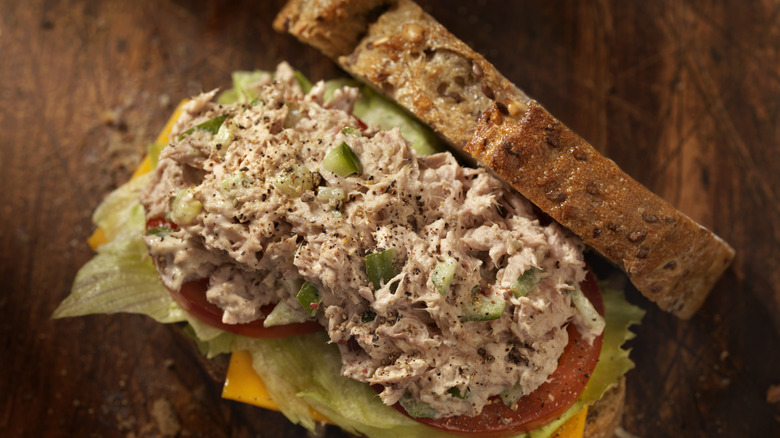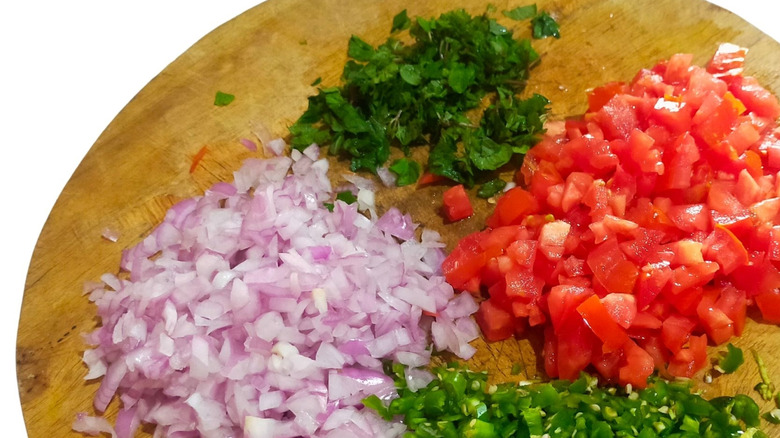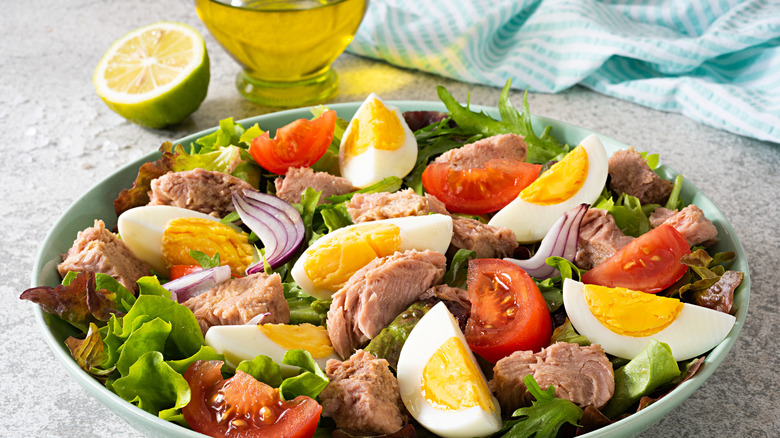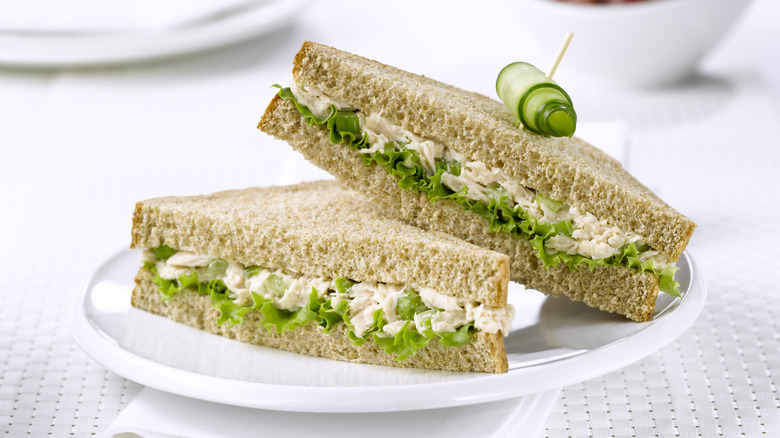14 Mistakes You'll Regret Making With Your Tuna Salad
Tuna salad is one of the great classics and so many people think it's an underrated dish. Tuna salad sandwiches are hardly ever a trendy menu item, but at home, it can be one of the most satisfying and easy lunches, snacks, or light dinners to make. Plus, it's also a nifty thing to take to a picnic, barbecue, or get-together of any kind, since you can whip up a big batch in one bowl, get some bread, and everyone can help themselves to something filling and delicious. I went from having tuna salad sandwiches for my school lunches as a kid, to taking them into work as an adult. Now as a professional caterer, I find that tuna salad is becoming a more common order for casual corporate lunches and retreats.
Everyone has their own rules about what must and mustn't go in a tuna salad. While the recipe is customizable, some people go a bit too wild with sauces, toppings, and add things that maybe shouldn't be in there (we all know that one Auntie or work colleague who adds raisins to everything). Or, there are other mistakes that people make with this sandwich that can make this simple meal go wrong. But don't despair, tuna salad can still be an easy and accessible thing to make for most home cooks — as long as you avoid these big potential mistakes.
Forgetting to drain the can
There's one step about making tuna salad that's not super appetizing: opening the can and tipping out as much of the liquid as possible. It smells very strong and can coat your kitchen sink in a fishy liquid that you have to clean up afterwards. However, this step is crucial to making a great tasting tuna salad — or any canned tuna-based meal for that matter. While the liquid inside of the can is edible, adding it to your tuna salad will dilute the other flavors and cause it to taste unpleasant.
Most people know you have to drain your tuna before using it, but if this is news to you, make sure you don't make this mistake from now on. To make it a bit easier to do the draining, open your can almost all the way around; only leave a little part of the lid attached. Then, hold down the lid with your fingers and tip over the can. That way, you can use the lid to press down on the tuna while the liquid pours out. You won't risk tuna chunks falling out too, and it allows you to squeeze out as much liquid as possible.
Not adding an acid
Canned tuna is a delicious and convenient food. It's salty and packed full of umami. But like any other fish or seafood dish, it needs something acidic to brighten it up and balance all that saltiness. The acidic component is often the one that's forgotten about when it comes to tuna salad. Lemon juice is the most obvious choice for most seafood, and it goes well with pretty much anything that needs a little hint of something acidic. Its subtle and mildly fruity flavor goes great with fish, including tuna.
If you only add one ingredient to your canned tuna, let it be lemon juice. This addition packs both flavor and acidity. However, you don't have to be limited to only lemon juice; vinegar can work just as well, too. Plus, your toppings and filling can also be an opportunity to introduce more acid. Pickles and bright and briny olives can be a tasty way to add more acid to your tuna salad, too.
Overdoing the mayo
One ingredient may automatically come to mind when you think about tuna salad: mayonnaise. Mayo is the perfect ingredient for all types of creamy salads, like egg salad, chicken salad, and of course, tuna salad. It adds all the creaminess you could ask for, while making everything tangy and delicious. Mayo also acts as the glue that binds everything together. Adding it to your salad helps make it cohesive and prevents it from separating.
The mayo can also balance out the strong, fishy flavor of the tuna. However, just like with anything in life, you can have too much of a good thing. If you've ever been a little heavy-handed with mayo, you've likely noticed that it can actually drown out the flavors and make your tuna salad a little bland. Likewise, adding too much mayo can also make your tuna salad extra gloopy and heavy. Tuna is already quite filling, so overdoing the mayo can make you feel unpleasantly full after having some.
The problem is that it's so easy to add too much mayo. Although there are plenty of accurate recipes for tuna salad online, it's the type of dish that most people don't bother looking at a recipe for, let alone measure out ingredients. A good rule of thumb is that you should always start with just a little; you can always add more mayo, but you can't take it out once you've added it. In my experience, 1 tablespoon of mayo is more than enough for 1 cup of tuna. Start with that, taste it, and adjust accordingly.
Choosing tuna brined in water over oil
With the right ingredients, you can make a good salad with any type of tuna. However, some tuna is better suited for your recipe than others. For a great tuna salad, it's always best to opt for oil-packed tuna over water-packed tuna. The briny water that tuna is packed in preserves it, but it does have a slightly diluted flavor compared to the oil-packed tuna. Plus, water-packed tuna tends to also dry out a little more than tuna packed in oil. Oil locks in the tuna's moisture, and helps to enhance the fish's natural richness.
While I always recommend draining the liquid from your tuna can, whether it's oil or water, it's not always possible to drain 100% of it. Inevitably, some of the liquid will still be left behind, and this is why oil is, once again, a better choice. Having some left over oil on your tuna will always be better than having can-flavored water with it. The water will make your salad more muddled and it won't bind with other ingredients the way oil does. If you want to shoot for the stars flavor-wise, then tuna packed in extra virgin olive oil will be your best bet. The oil itself is tasty and offers an exceptionally silky flavor.
Forgoing the crunch
One mistake that many people make with tuna fish is forgetting to incorporate a crunchy element. A good tuna salad has textural variation; it's not just a big pile of mushy tuna with mayo. Sure, you want a soft and creamy tuna mixture, but meshing soft and crunchy together is key. There are plenty of ways to add some crunch, one of the easiest of which is using chopped red onion and celery. Adding crunchy vegetables and alliums, like onions, celery, cucumbers, pickles, and even things like carrots and apples, can add some variety that makes your tuna salad feel fresh and will certainly send you back for seconds.
You can even add some crushed potato chips to double up on the crunch. The internet went wild for Matthew McConaughey's tuna salad – and one of the ingredients that makes it so tasty is the addition of jalapeño chips. These chips make the salad texturally satisfying and add extra jalapeño and salty flavor. Could it get any more enticing than that?
Underseasoning the tuna salad
Seasoning can make or break a meal. If a dish is bland, or lacking something, it can often be attributed to under-seasoning. Seasoning has to do with salt for sure, but it's so much more than just that. Seasoning can include spices of all kinds, whether it's common, simple spices like black pepper and paprika, or even spice blends that have been store-bought or put together at home. Spice or seasoning blends can also include other flavor boosters like dried herbs, dried onion, or garlic powder. You can also use sauces and condiments beyond dry seasoning, like soy sauce, sesame oil, Worcestershire sauce, mustard, and more, to pump up your meal with delicious aromas and flavors.
People often make the mistake of thinking that the tuna is already salty and strongly-flavored. Just adding mayo can make an okay, yet bland, tuna salad. So, don't hold back on trying different spices, herbs, or other seasonings to make your tuna salad taste great, balanced, and full-bodied. For a simple idea, why not try a sriracha mayo, or throw in some paprika, lemon juice, black pepper, and a couple drops of Italian dressing to add some extra zing?
Leaving out fresh herbs
Fresh herbs aren't usually the first thing that you'd think of adding to tuna salad — and that's unfortunate. Greens are actually pretty delicious in tuna salad, and they tend to give the salad a dynamic taste and unique freshness. Herbs are like little leaves of concentrated flavor, and that essence can lift your tuna salad to new heights. You can go with fresh parsley if you're a little unsure of where to start, but don't stop there. Herbs like mint, basil, dill, and cilantro have a place in tuna salad — depending on the other flavor pairings you use.
You can also mix a whole bunch of fresh herbs into your tuna salad dressing, or make a salsa verde-type sauce to dress it with. For a fresh, crunchy and herby magic, make this green goddess style tuna salad with fresh chives, tarragon, flat-leaf parsley, and basil. You'll never have to settle for a bland or boring tuna salad again.
Using bread that's not fresh
If you've gone all out and given your tuna salad a lot of love and attention, you don't want to let it all down in the final moment by using average bread. Even though tuna salad is the star, the bread you serve it on is close to half of the meal, so choosing the right bread matters. A little advance preparation or a visit to a bakery can help you make the best out of your sandwich.
Always use fresh bread, as stale or even highly-processed bread can ruin the meal. It's also a good idea to choose a crusty bread that can hold tuna salad well without breaking or falling apart. A good country loaf, ciabatta, or a freshly-baked sourdough are all great choices. Toasting the bread can give make it even stronger and will help prevent sogginess. Plus, it will add even more crunch to your tuna salad sandwich.
Not chopping everything consistently
A great tuna salad isn't only about the ingredients you put it in, but also how you go about adding them. The way you cut and chop your veggies and other additions can alter the texture of your salad, and that's why it's a good idea to attempt to chop everything consistently. That way, you can enjoy an even mouthful of tuna salad. If some veggies are a lot more chunky than others, it can throw off the texture and flavor and make the salad less cohesive.
Chopping things evenly is a good start, but ideally, you want to chop them pretty finely, too. Though, you don't want to mince your add-ins, as you still want them to have enough crunch. Chopping your veggies finely and mixing them will ensure that you get a little bit of every flavor in each bite.
Relying only on mayo
Mayo may seem like the essential ingredient to start with, but there are other sauces and spreads you can use to upgrade your tuna salad. You can use "mayo-adjacent" sauces or ingredients for a creamy salad, too. For example, you can swap out mayo for aioli for an elevated tuna salad. This can be made even more luxurious if you use garlic, lemon, truffle, or other flavored aioli.
If you want to make a lighter tuna salad, you can even use avocado instead of mayo to make your creamy dressing. Avocados are like Earth's butter, and when mashed or creamed, they make a beautiful velvety paste that can be mixed into a saucy consistency. Or you could leave out the "creamy" factor altogether and take a page out of Rachael Ray's playbook. She ditches the mayo for a dressing made with extra virgin olive oil and lemon juice. This mixture can still add a lot of tang and silky richness without the need for a mayo-based sauce.
Serving it warm
A picnic, hike, or outdoor gathering may be the best thing to take a tuna salad to, but you'll want to pack it in a way that keeps it cool. There's nothing as sad as taking out a room temperature, or even warm, tuna salad. Although you may have perfected your recipe and made everything is taste great, the dish can lose some of that appeal if it's served warm.
Unless you're going to go full on hot with your tuna salad sandwich — by turning it into a tuna melt or tuna toastie — make sure to keep it refrigerated for as long as possible until serving it. So if you're planning to take it outdoors, it's worth keeping it in a cooler box or bag. It might take a little extra care to keep it chilled, but everyone who eats it will thank you for it.
Not storing or refrigerating the tuna salad properly
Tuna salad should be refrigerated because it's not a shelf-stable food. Neither mayo nor tuna is safe to be kept unrefrigerated for long periods of time. Besides tasting bad, there are health risks associated with keeping tuna salad out for too long. The United States Department of Agriculture (USDA) recommends that foods like tuna salad be left out at room temperature for no more than two hours.
To store your tuna salad properly, pop it into an air-tight container. As with any fish and seafood, it's recommended that you eat it within three or four days, per the USDA. After that, you should discard it. So, as tempting as it might be to make a big batch of tuna salad for the week, you should only make enough to feed you for about three days.
Adding it to your bread too early
The type of bread you choose for your tuna salad sandwich isn't the only thing that matters. You also want to get the timing right. Preparing tuna salad sandwiches in advance may be convenient and save you time later (and make for a yummy lunch at work), but you will risk a soggy sandwich. Tuna salad is wet, and there's no way around that. So if you add it to your bread and let it sit for a couple of hours, there's no way your bread won't soak up all the juice and become soft and mushy.
You can avoid all this by only adding your salad to your bread just before eating it. Even if you're taking it to a gathering or to work, keep your salad and bread separate. It's not too difficult to pack your salad in a takeout container or lunchbox and keep your slices of bread in a little bag on the side. Then, when it's time to eat, simply spread the salad on your bread and enjoy a sandwich that tastes super fresh, with all the textural variation that makes it delicious.
Including raisins in tuna salad
One of the worst things about digging into someone's homemade tuna salad is finding little plump raisins in the mix. I don't want to yuck your yum if you really love putting raisins in your tuna salad. Perhaps you like adding them to your potato salad (which you shouldn't do either, in my opinion) and mistakenly thought they could just as well go in a tuna salad. Unless you're strongly attached to this idea, it's best to skip the dried fruit. Even if you like something sweet in your tuna salad, raisins are way too sweet and really don't go well with tuna (or most fish dishes in general), as they tend to throw everything off.
I personally think that tuna salad is perfectly delicious and doesn't need a sweet element. But if you must add something sweet, then opt for green apples instead. They'll add some crunch and a little sweetness, but they aren't overly sweet. However, I think your salad will be perfect with some chopped celery, onions, and no fruit at all.














